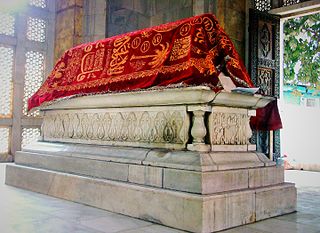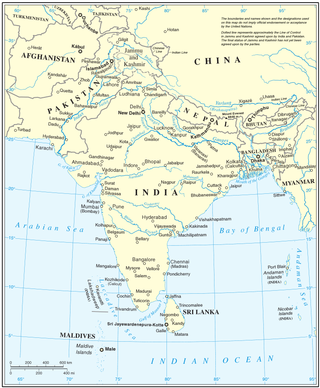Related Research Articles

The Delhi Sultanate or the Sultanate of Delhi was a late medieval empire primarily based in Delhi that stretched over large parts of the Indian subcontinent, for 320 years (1206–1526). Following the invasion of South Asia by the Ghurid dynasty, five dynasties ruled over the Delhi Sultanate sequentially: the Mamluk dynasty (1206–1290), the Khalji dynasty (1290–1320), the Tughlaq dynasty (1320–1414), the Sayyid dynasty (1414–1451), and the Lodi dynasty (1451–1526). It covered large swaths of territory in modern-day India, Pakistan, and Bangladesh as well as some parts of southern Nepal.
The Ghaznavid dynasty or the Ghaznavid Empire was a Persianate Muslim dynasty and empire of Turkic mamluk origin, ruling at its greatest extent, large parts of Persia, Khorasan, and the northwest Indian subcontinent from 977 to 1186. The dynasty was founded by Sabuktigin upon his succession to the rule of Ghazna after the death of his father-in-law, Alp Tigin, who was an ex-general of the Samanid Empire from Balkh, north of the Hindu Kush in Greater Khorasan.

Abu al-Qasim Mahmud ibn Sabuktigin, usually known as Mahmud of Ghazni or Mahmud Ghaznavi, was Sultan of the Ghaznavid Empire, ruling from 998 to 1030. At the time of his death, his kingdom had been transformed into an extensive military empire, which extended from northwestern Iran proper to the Punjab in the Indian subcontinent, Khwarazm in Transoxiana, and Makran.

Mu'izz ad-Din Muhammad ibn Sam, also known as Muhammad of Ghor or Muhammad Ghori, was a ruler from the Ghurid dynasty based in the Ghor region of what is today central Afghanistan who ruled from 1173 to 1206. Muhammad of Ghor and his elder brother Ghiyath al-Din Muhammad ruled in a dyarchy until the latter's death in 1203. Ghiyath al-Din, the senior partner, governed the western Ghurid regions from his capital at Firozkoh whereas Muhammad of Ghor extended Ghurid rule eastwards, laying the foundation of Islamic rule in South Asia, which lasted after him for nearly half a millennium under evolving Muslim dynasties.

Shams ud-Din Iltutmish was the third of the Mamluk kings who ruled the former Ghurid territories in northern India. He was the first Muslim sovereign to rule from Delhi, and is thus considered the effective founder of the Delhi Sultanate.

Qutb ud-Din Aibak, was a general of the Ghurid emperor Muhammad Ghori. He was in charge of the Ghurid territories in northern India, and after Muhammad Ghori's assassination in 1206, he established the Delhi Sultanate (1206–1526), and started the Mamluk dynasty, which would rule the Sultanate until 1290.
The Muzaffarid dynasty, sometimes referred as Ahmedabad dynasty, were Sultans of Gujarat in western India from 1391 to 1583. The founder of the dynasty was Zafar Khan who was governor of Gujarat under the suzerainty of the Tughlaq dynasty of the Delhi Sultanate. When the Sultanate was weakened by the sacking of Delhi by Timur in 1398, and Zafar Khan took the opportunity to establish himself as sultan of an independent Gujarat. His son, Ahmed Shah I established the capital at Ahmedabad. The dynasty ruled for almost 200 years, until the conquest of Gujarat by the Mughal Empire in 1572. The sultanate reached its peak of expansion under Mahmud Begada, reaching east into Malwa and west to the Gulf of Kutch.

The Khalji or Khilji dynasty was the second dynasty which ruled the Delhi sultanate, covering large parts of the Indian subcontinent for nearly three decades between 1290 and 1320. It was founded by Jalal ud din Firuz Khalji.

The Gahadavala dynasty also Gahadavalas of Kannauj was a Rajput dynasty that ruled parts of the present-day Indian states of Uttar Pradesh and Bihar, during 11th and 12th centuries. Their capital was located at Banaras in the Gangetic plains, and for a brief period, they also controlled Kannauj.
The Ghurid dynasty was a Persianate dynasty of presumably eastern Iranian Tajik origin, which ruled from the 8th-century in the region of Ghor, and became an Empire from 1175 to 1215. The Ghurids were centered in the hills of Ghor region in the present-day central Afghanistan, where they initially started out as local chiefs. They gradually converted to Sunni Islam after the conquest of Ghor by the Ghaznavid ruler Mahmud of Ghazni in 1011. The Ghurids eventually overran the Ghaznavids when Muhammad of Ghor seized Lahore and expelled the Ghaznavids from their last stronghold.
Muslim Rajputs or Musalman Rajpoots are the descendants of Rajputs in the northern regions of the Indian subcontinent who are followers of Islam. They converted from Hinduism to Islam from the medieval period onwards, creating various dynasties and states while retaining Hindu surnames such as Chauhan. Today, Muslim Rajputs can be found mostly in present-day Northern India and Pakistan. They are further divided into different clans.

Ikhtiyār al-Dīn Muḥammad Bakhtiyār Khaljī, also known as Bakhtiyar Khalji, was a Turko-Afghan military general of the Ghurid ruler Muhammad of Ghor, who led the Muslim conquests of the eastern Indian regions of Bengal and Bihar and established himself as their ruler. He was the founder of the Khalji dynasty of Bengal, which ruled Bengal for a short period, from 1203 to 1227 CE.
Minhaj-al-Din Abu Amr Othman ibn Siraj-al-Din Muhammad Juzjani, simply known as Minhaj al-Siraj Juzjani, was a 13th-century Persian historian born in the region of Ghur.

Ghiyath al-Din Muhammad, also known as Ghiyath al-Din Ghori or Ghiyassuddin Ghori born, Muhammad, was the Sultan of the Ghurid dynasty. During the diarchy of Ghiyath and his younger brother Muhammad of Ghor who governed the eastern realm of the Ghurid Empire, the Ghurids emerged as one of the greatest power of the eastern Islamic world.
The Tarikh i Yamini, or Kitab i Yamini, written in Arabic in an embellished, flowery rhetorical rhymed prose, is a history of the reigns of Sebuktigin and Mahmud.
The Khalji dynasty was the first Muslim dynasty to rule Bengal. The dynasty, which hailed from the Garmsir region of present-day Afghanistan, was founded in 1204 by Muhammad Bakhtiyar Khalji, a Muslim Turko-Afghan general of the Ghurid Empire. The Khaljis initially pledged allegiance to Sultan Muhammad of Ghor until his death in 1206, though their rule in Bengal was mostly independent. Under the rule of Iwaz Khalji, Bengal experienced major developments such as its first naval force, flood defence systems and linkage with the Grand Trunk Road. The dynasty was based in the city of Lakhnauti in northern Bengal, later expanding eastwards and southwards. Nasiruddin Mahmud, the son of Mamluk sultan Iltutmish of Delhi managed to conquer Bengal in 1227; although the Khaljis briefly reasserted their independence, they surrendered to the Mamluks in 1231, who replaced them with a series of regional governors.

Islam is the second-largest religion in South Asia, with more than 640 million Muslims living there, forming about one-third of the region's population. Islam first spread along the coastal regions of the Indian subcontinent and Sri Lanka, almost as soon as it started in the Arabian Peninsula, as the Arab traders brought it to South Asia. South Asia has the largest population of Muslims in the world, with about one-third of all Muslims living here. Islam is the dominant religion in half of the South Asian countries. It is the second largest religion in India and third largest in Sri Lanka and Nepal.

The Indian campaigns of Muhammad of Ghor were a series of invasions for 31 years (1175-1206) by the Ghurid ruler Muhammad of Ghor in the last quarter of the twelfth and early decade of the thirteenth century which lead to the widespread expansion of the Ghurid empire in the Indian subcontinent.
The siege of Lahore in 1186 brought the end of Ghaznavid rule with Muhammad of Ghor annexing their last-surviving principality from Khusrau Malik.
References
- 1 2 3 4 5 6 7 8 "Profile". Aligarh Muslim University. Retrieved 12 January 2013.
- 1 2 3 "Centre Of Advanced Study - Department of History - Aligarh Muslim University >> Faculty/Publications". Centre Of Advanced Study - Department of History - Aligarh Muslim University. Archived from the original on 3 December 2012. Retrieved 12 January 2013.
- ↑ Raza, S. Jabir (2004). The Jats of Punjab and Sind: Their Settlements and Migrations (c. 5th-12th AD).
- ↑ Suraj Mal Memorial Education Society Centre for Research and Publication (2006). The Jats: their role & contribution to the socio-economic life and polity of north & north-west India. Vol. 2. Originals. p. 52. ISBN 8188629529.
- ↑ Suraj Mal Memorial Education Society Centre for Research and Publication (2006). The Jats: their role & contribution to the socio-economic life and polity of north & north-west India. Vol. 2. Originals. p. 52,63. ISBN 8188629529.
- ↑ Sharma, Gauri (2006). Prime ministers under the Mughals, 1526-1707. Kanishka Publishers. p. 16. ISBN 8173918236.
33. Syed Jabir Raza, "Ghaznavid Origins of the Administrative Institutions of the Delhi Sultanat". P.I.H.C., 1992, New Delhi, pp. 232-41.
- ↑ Indian History Congress (2007). Proceedings of the Indian History Congress. Vol. 67 (illustrated ed.). Indian History Congress. pp. xiii.
28. Epigraphic Evidence for Officials and Administrative Offices in the Delhi Sultanate S. Jabir Raza, Aligarh, AM-14253
- ↑ Auer, Blain H. (2012). "Bibliography". Symbols of Authority in Medieval Islam: History, Religion and Muslim Legitimacy in the Delhi Sultanate. Vol. 6 of Library of South Asian history and culture (illustrated ed.). I.B.Tauris. p. 215. ISBN 978-1848855670.
Raza, S. Jabir. "Nomenclature and Titulature of the Early Turkish Sultans of Delhi Found in Numismatic Legends." In Medieval Indian Coinages: A Historical and Economic Perspective, edited by Amiteshwar Jha, 85-96. Nasik: Indian Institute of Research in Numismatic Studies, 2001.
- ↑ Bleaney, C. Heather; Gallego, María Ángeles (2006). Afghanistan: A Bibliography. BRILL. p. 212. ISBN 900414532X.
3068 RAZA, S. Jabir. Iqta' system in the pre-Ghurid kingdoms and its antecedents. Proceedings of the Indian History Congress: 54th Session (1993), Mysore. Delhi: Indian History Congress, 1994, pp. 707-713. [Iran & Afghanistan]
- ↑ Bleaney, C. Heather; Gallego, María Ángeles (2006). Afghanistan: A Bibliography. BRILL. p. 212. ISBN 900414532X.
3069 RAZA, S. Jabir. The Afghans and their relations with the Ghaznavids and the Ghurids. Proceedings of the Indian History Congress, 55th Session, Aligarh, 1994. Delhi: Indian History Congress, Department of History, University of Delhi, 1995, pp. 784-791.
- ↑ U. P. History Congress (2007). Rizavī, Saiyada Najamula Razā; Jafri, Saiyid Zaheer Husain (eds.). Explorations in Indian History. Anamika Pub & Distributors. p. 6. ISBN 978-8179751671.
Page 6: "12. Sultan Mahmud's Military Route to Kannauj — S. Jabir Raza. Page 16: "12. S. Jabir Raza, Department of History, Aligarh Muslim University, Aligarh (U.P.)